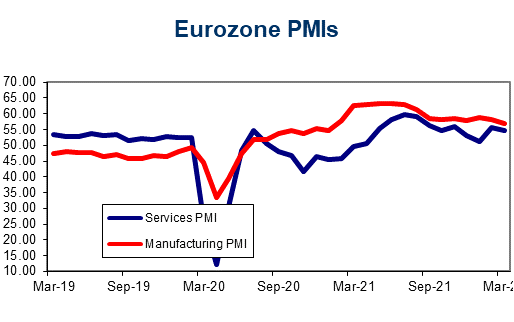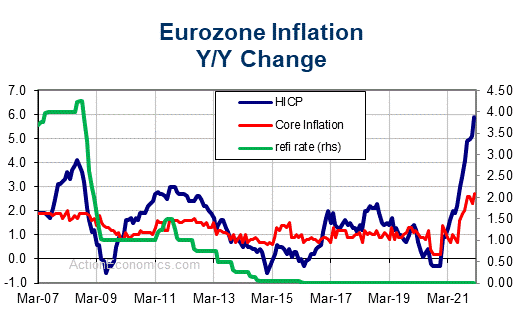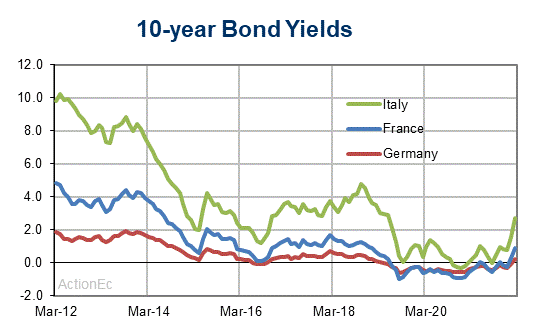The markets are looking ahead to the ECB meeting this week. Over recent days, the ECB officials have been trying to manage reflation trades and slow the ascent in yields, although most recent comments have backed the view that the central bank will leave policy settings unchanged. Both the Fed and ECB have been implicitly endorsing the trajectory of rising yields amid expectations for a strong rebound in growth later in the year, even if policymakers are clearly eager to prevent excessive moves. Against that background the ECB is unlikely to deliver anything but soothing words for bond markets this week but Lagarde will stress the flexibility on asset purchases that the PEPP program provides already.
It’s highly possible President Lagarde will deliver a dovish presser, but at the same time, she is likely to re-affirm the central scenario of strengthening growth in the second half of the year. Indeed, updated staff projections are unlikely to bring major revisions and on the inflation front could actually come in a tad higher than in December — at least for this year, as cost pressures in supply chains are building.
Ongoing virus restrictions are still likely to see the Eurozone posting another quarter of negative growth in Q1 this year, but even if vaccinations are slow, they are proceeding, and consumption is set to bounce again later in the year, while manufacturing is already expanding at a solid pace. Key ECB figures have reiterated that the central scenario remains for a strong rebound in H2 and against that background, dovish comments mean the ECB won’t exit the extremely generous monetary policy settings any time soon; on the contrary the central bank will add to existing measures.

ECB’s Panetta said recently that “we are already seeing undesirable contagion from rising US yields into the euro area yield curve” and that “the steepening in the nominal GDP-weighted yield curve…is unwelcome and must be resisted”. Similarly, Executive Board member Schnabel said last Friday that “a rise in real long-term rates at the early stages of the recovery, even if reflecting improved growth prospects may withdraw vital policy support too early and too abruptly given the still fragile state of the economy” adding that “policy will then have to step up its level of support”.
Meanwhile ECB’s Villeroy recently flagged the possibility of a deposit rate cut, and clearly at the current juncture it remains crucial to assure markets that the ECB hasn’t run out of options should things take another turn for the worse. However, that doesn’t mean these options will be used. Indeed, ECB’s Weidmann actually played down the rise in yields, saying that he “would tend to argue that the size of the movements is not such that this is a particularly worrisome development”. And while one could dismiss this as a hawkish minority view from the Bundesbank President Weidmann, Vice President de Guindos also sounded relatively relaxed yesterday when he stressed that in terms of spreads the situation is very calm, while highlighting that the recent increase of nominal yields came on the back of very low levels.

Indeed, real rates have actually declined since the end of last year, thanks to a jump in Eurozone headline inflation as Germany’s temporary VAT cut fell out of the equation. Eurozone HICP inflation stood at 0.9% in February, after ending 2020 in negative territory. Note that, for the ECB the 10-year spread over the German benchmark is below the average over the past year for France, Spain, Italy, Portugal and essentially most Eurozone countries.
Even if there was a problem, as ECB officials have pointed out, the PEPP program, which was strengthened again at the end of last year, offers sufficient flexibility to react, should it be necessary. The overall envelope for asset purchases under the PEPP program is already quite generous and also allows the central bank to target yields if necessary, by diverging from purchases according to the capital key. No need to tweak official policy settings then, especially as the central bank’s central scenario remains for a marked recovery in the second half of the year.

PEPP purchases will likely become more important in managing yields in the coming months, especially if cost pressures, which are evident in survey findings, feed through to headline inflation. Overall activity may be set to contract again in the first quarter, but the manufacturing sector is already seeing very strong demand and while labour costs are likely to remain subdued, input price inflation is picking up sharply, not just in the Eurozone. That will likely continue to underpin volatility in global markets with risks of overshooting in yields as it increasingly becomes clear that monetary policy won’t get any more relaxed than it is at the moment. Central banks meanwhile have the difficult task of trying to lay the ground for a turnaround in policy without spooking markets too much, but also without letting inflation expectations run higher, which could happen if and when economies have re-opened and consumption bounces back. Just when and to what extent that rebound in consumption will unfold remains uncertain at the moment and that will leave central banks essentially in wait and see stance and hedging their bets in either direction.
Click here to access the our Economic Calendar
Andria Pichidi
Market Analyst
Disclaimer: This material is provided as a general marketing communication for information purposes only and does not constitute an independent investment research. Nothing in this communication contains, or should be considered as containing, an investment advice or an investment recommendation or a solicitation for the purpose of buying or selling of any financial instrument. All information provided is gathered from reputable sources and any information containing an indication of past performance is not a guarantee or reliable indicator of future performance. Users acknowledge that any investment in Leveraged Products is characterized by a certain degree of uncertainty and that any investment of this nature involves a high level of risk for which the users are solely responsible and liable. We assume no liability for any loss arising from any investment made based on the information provided in this communication. This communication must not be reproduced or further distributed without our prior written permission.


















